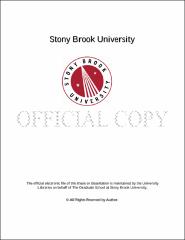| dc.identifier.uri | http://hdl.handle.net/11401/76901 | |
| dc.description.sponsorship | This work is sponsored by the Stony Brook University Graduate School in compliance with the requirements for completion of degree. | en_US |
| dc.format | Monograph | |
| dc.format.medium | Electronic Resource | en_US |
| dc.language.iso | en_US | |
| dc.publisher | The Graduate School, Stony Brook University: Stony Brook, NY. | |
| dc.type | Dissertation | |
| dcterms.abstract | Aging is the biological process of growing older in a deleterious sense, senescence. However, what we have gained only comprises a partial and incomplete understanding of the fundamental molecular mechanisms. Increasing evidence suggests that dysregulation of the metabolism of sphingolipids including sphingoid bases (SBs, long-chain bases) might play an important role in the aging. We know neither how SBs are regulated during yeast aging nor how they, in turn, regulate it. Herein, I demonstrate that the yeast alkaline ceramidases (YPC1 and YDC1) and SB kinases (LCB4 and LCB5) cooperate in regulating SBs during the aging process and that SBs shorten chronological life span (CLS) by compromising mitochondrial functions. With a lipidomics approach, I found that SBs were increased in a time-dependent manner during yeast aging. I also demonstrated that among the enzymes known for being responsible for the metabolism of SBs, YPC1 was upregulated whereas LCB4/5 were downregulated in the course of aging. This inverse regulation of YPC1 and LCB4/5 led to not only the aging-related upregulation of SBs in yeast but also a reduction in CLS. With the proteomics-based approach (SILAC), I revealed that increased SBs altered the levels of proteins related to mitochondria. Further mechanistic studies demonstrated that increased SBs inhibited mitochondrial fusion and caused fragmentation, resulting in decreases in mtDNA copy numbers, ATP levels, mitochondrial membrane potentials, and oxygen consumption. As the metabolism of sphingolipids is highly conserved between yeast and mammalian cells, these important findings would also facilitate our understanding of the role and mechanism of the action of sphingolipids and their metabolizing enzymes in physiological and pathological aging of humans and other mammals. | |
| dcterms.available | 2017-09-20T16:51:24Z | |
| dcterms.contributor | Mao, Cungui | en_US |
| dcterms.contributor | Hannun, Yusuf | en_US |
| dcterms.contributor | Demple, Bruce | en_US |
| dcterms.contributor | Obied, Lina | en_US |
| dcterms.contributor | Frohman, Michael | en_US |
| dcterms.contributor | Rigas, Basil. | en_US |
| dcterms.creator | Yi, Jae Kyo | |
| dcterms.dateAccepted | 2017-09-20T16:51:24Z | |
| dcterms.dateSubmitted | 2017-09-20T16:51:24Z | |
| dcterms.description | Department of Biochemistry and Cell Biology | en_US |
| dcterms.extent | 153 pg. | en_US |
| dcterms.format | Monograph | |
| dcterms.format | Application/PDF | en_US |
| dcterms.identifier | http://hdl.handle.net/11401/76901 | |
| dcterms.issued | 2016-12-01 | |
| dcterms.language | en_US | |
| dcterms.provenance | Made available in DSpace on 2017-09-20T16:51:24Z (GMT). No. of bitstreams: 1
Yi_grad.sunysb_0771E_12940.pdf: 3412183 bytes, checksum: 5328a1131dbbfcdce901166a45ef89df (MD5)
Previous issue date: 1 | en |
| dcterms.publisher | The Graduate School, Stony Brook University: Stony Brook, NY. | |
| dcterms.subject | Molecular biology -- Biology -- Molecular chemistry | |
| dcterms.subject | Aging, Lipid, Mitochondria, Sphingoid bases, Sphingolipid, Yeast | |
| dcterms.title | Aging-related elevation of sphingoid bases shortens yeast chronological life span by compromising mitochondrial function | |
| dcterms.type | Dissertation | |

